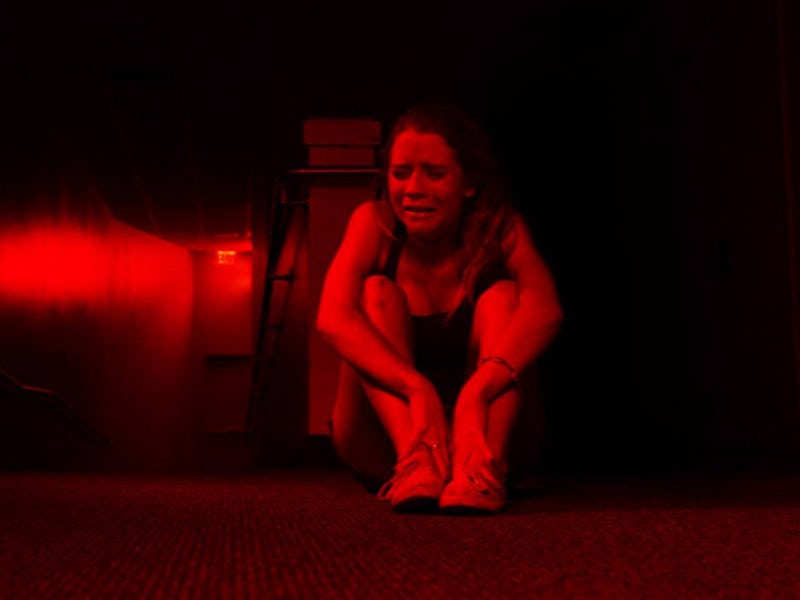'The Gallows' Delivers the Year's Most Illogical Scares
The newest "found footage" horror film contributes little to the popular and cost-effective subgenre

Anyone who’s been involved in any sort of self-serious theatrical production will recall at least one silly backstage superstition; “Break a leg!” is only the tip of the iceberg. One of the most widely syndicated is a moratorium on saying “Macbeth” backstage. One time, the play’s title character is said to have died suddenly during or after the production (accounts vary); therefore, the play is cursed, and can only be referred to as “the Scottish play.”
Blumhouse Production’s newest el cheapo “found footage” horror flick, The Gallows, is set during a production of a different (and fictional) bewitched play. The play-within-the-film “The Gallows” fits stylistically somewhere between The Crucible and the New England gothic of Nathaniel Hawthorne.
During a 1993 production at a small-town Nebraska high school (it feels more SoCal), a seemingly supernaturally precipitated death occurs onstage: The play’s main character, played by one Charlie Grimille, is actually hung during the climatic gallows scene by some invisible force. Now, the play has been revived (exactly twenty years later, and for no clear reason) at the same high school. Speaking Charlie’s name — explains the play’s new female lead and resident Beatrice HS drama princess, Pfeifer Ross (Pfeifer Brown) — is regarded as tempting bad spirits and not to be spoken in the theater. Ryan Shoos (played, also, by a Ryan Shoos) — the film’s primary character, second-string footballer, diligent candid cameraman, and unrelenting asshole — laughs in the face of the tradition, mocking all the things “theater nerds” aren’t allowed to say.
Without spoiling anything big, his obnoxious flouting of Pfeifer’s recommendation will quite literally cripple him when things get dicey later in the film.
In the same way as the superior Paranomal Activity movies gain their mileage from creepy children and their devil-child-bearing mothers, The Gallows mines the nooks and crannies of an unrefurbished high school. Did you know how creepy an overstuffed costume room can be when lit solely by your iPhone’s LED flashlight?
The film’s action centers around Ryan, his cheerleader girlfriend Cassidy (Cassidy Spilker) and quarterback-turned-theatrical-leading-man Reese (Reese Mishler) enter the school auditorium late at night to destroy “The Gallows”’ set just before opening night. Reese, who only agreed to do the lead part because of his crush of Pefifer, participates in Ryan’s sordid plan to dismantle the production (inspired, mostly, by his hatred of nerds) believing that he fanangle himself closer to Pefifer in her time of grief — when she realizes the play has been sabotaged. However, Pefifer shows up at the school right when the three popular kids have begun their dirty work, sabotaging their plan. Then the far-off slams and spooky rumbles get going in earnest, and the four teens are forced to band together to battle a dizzying and eventually tedious army of mysteriously locked doors, failing phone batteries (no more flashlights in horror film expeditions) and a mysteriously reassembling stage set to find their way back out of the school.
In the same way that other genres of film work overtime to make you care about the main characters, The Gallows, like so many good slasher movies, aims for the exact opposite. Ryan is omnipresent in the film’s first half (which feels like much more of it), taunting tech theater wusses, mocking unattractive girls, alternately hanging on and taunting Reese (his best friend), and basically providing a source of constant irritation. In, say, the Friday the 13th franchise, the annoying, boorish and hormone-fueled behavior of the cohort of campers (that which makes you almost root for Jason to creatively dispose of them) inspires laughs; it’s artfully campy. Ryan’s portion of the film lacks any humor, though it often aims for it. Therefore, the first half of the film functions simply as an unsuccessful, sloppy and lethargic setup for a extremely flimsy narrative concept. It makes the scares and revelations (Charlie was only supposed to be the understudy! Reese’s dad, then in high school, was supposed to be in the noose!) feel anti-climactic when they do finally come. They are more simple reliefs — finally, something is happening, even if we don’t exactly know or care why.
However, the spectral, hooded “hangman”/Charlie character — who eventually appears to noose the insensitive and entitled enemies of drama — delivers a couple of memorably chilling moments. There is a pretty effective (if nonsensical) twist regarding Pfeifer’s character and an unexpected witch intercession to boot. The high school itself, which is explored from dank basement to rickety, asbestos-filled catwalk, is effectively the film’s main character. A scene in which a tangle of nooses appear, threaded through some disintegrating PVC pipes, is particularly memorable, if silly. Placing firmly below even the later Paranormal films in quality and likely only to gain mileage as a recommendation for additional “Horror” viewing on Netflix, The Gallows is strictly bored-horror-fans only.